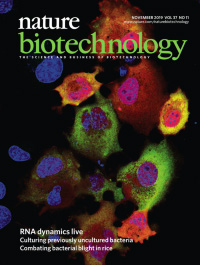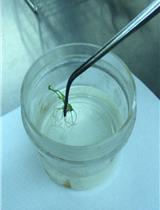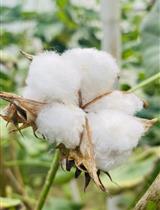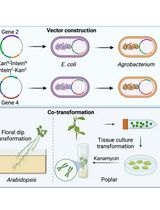- EN - English
- CN - 中文
Efficient Agrobacterium-mediated Transformation of the Elite–Indica Rice Variety Komboka
农杆菌介导的优良籼稻品种Komboka的高效转化
发布: 2020年09月05日第10卷第17期 DOI: 10.21769/BioProtoc.3739 浏览次数: 9611
评审: Guotian LiDaniel F. CaddellAnonymous reviewer(s)
Abstract
Genetic transformation is crucial for both investigating gene functions and for engineering of crops to introduce new traits. Rice (Oryza sativa L.) is an important model in plant research, since it is the staple food for more than half of the world’s population. As a result, numerous transformation methods have been developed for both indica and japonica rice. Since breeders continuously develop new rice varieties, transformation protocols have to be adapted for each new variety. Here we provide an optimized transformation protocol with detailed tips and tricks for a new African variety Komboka using immature embryos. In Komboka, we obtained an apparent transformation rate of up to 48% for GUS/GFP reporter gene constructs using this optimized protocol. This protocol is also applicable for use with other elite indica rice varieties.
Keywords: Agrobacterium-mediated transformation (农杆菌介导转化)Background
Various methods for genetic transformation of plants have been developed, e.g. PEG-mediated transfection of protoplasts (Shimamoto et al., 1989; Datta et al., 1992), biolistic transformation (Christou et al., 1991) and Agrobacterium-mediated transformation (Slamet-Loedin et al., 2014). Agrobacterium-mediated transformation is one of the most widely used methods to introduce DNA into plants (van Wordragen and Dons, 1992). This method has been used intensively for research and has become a key prerequisite for biotechnology. It has gained in importance since the development of new breeding technologies such as genome editing (Char et al., 2019). For crops, such as rice, genetic transformation could also be used to develop new genetic variations for plant breeding, for example, creating new disease- or insect-resistant lines (Cheng et al., 1998; Helliwell and Yang, 2013; Oliva et al., 2019). Also for rice, Agrobacterium-mediated transformation is the most popular method to transfer T-DNA into plant genomes (Hiei and Komari, 2008). Currently, there are multiple protocols for japonica and indica rice transformation using calli induced from mature seeds or immature embryos (Hiei and Komari, 2006 and 2008; Toki et al., 2006; Nishimura et al., 2006; Sahoo et al., 2011; Sahoo and Tuteja, 2012; Slamet-Loedin et al., 2014; Sundararajan et al., 2017). It is convenient to use mature seeds for transformation because they are available throughout the year and can be stored, although this method is predominantly used for japonica varieties. Methods that involve transformation of rice immature embryos generally yield higher transformation rates compared to mature seeds (Hiei and Komari, 2008; Slamet-Loedin et al., 2014). Overall, japonica varieties such as Kitaake and Nipponbare are apparently easier to transform, compared to indica rice such as IR64 or Ciherang-Sub1 (Oliva et al., 2019). For japonica varieties, highly efficient transformation can be obtained using calli induced from mature seeds with rates of 50-60% (Li et al., 2015). For indica varieties, despite some efforts to increase transformation rate using mature seeds, immature embryos-derived calli are still the tissue of choice for transformation. Notably, transformation efficiency is highly variety-dependent and it is necessary to optimize transformation protocols for each variety.
Komboka (IR 05N 221) is a new elite variety generated by IRRI and released in Tanzania by the National Rice Research Program-KATRIN Research Centre and IRRI-Tanzania (‘Komboka’ = ‘liberated’) (Kitilu et al., 2019). Komboka is high yielding (8.6 t ha-1), semi-aromatic with good grain quality, tolerant to blast and well adapted to upland and lowland areas. In the protocol reported here, we describe detailed steps for the stable transformation of Komboka immature embryos which produce transgenic plants within four months and with a high apparent transformation rate of up to 48%. This protocol was developed by combining and modifying published protocols from Slamet-Loedin et al., 2014 and Hiei and Komari, 2008 which were used to transform different indica rice varieties such as IR64, Ciherang-sub1 (Oliva et al., 2019), therefore, in principle this protocol can likely be adapted for transformation of other indica rice varieties. In this protocol, we highlighted all details, tips and tricks that are essential for setting up transformation protocols for other elite varieties.
Figure 1. Flow chart and timeline for Agrobacterium-mediated transformation of immature embryos of rice var. Komboka (indica) which takes about four months to generate transgenic lines. Briefly, the process starts with growing rice plants to the flowering stage under controlled greenhouse conditions at 30 °C ± 2 °C during the day and 25 °C ± 2 °C during the night, 50-70% relative humidity. Light conditions in the glass greenhouse are determined by natural daylight and additional lamplight (8/16 day/night photoperiod). Daylength varies in the course of the seasons due to the location of our greenhouse along latitude (latitudes and longitudes of Düsseldorf, Germany 51°11'31.2"N 6°47'40.1"E). Under these conditions, Komboka required 13-14 weeks till booting stage and additional 2-3 weeks to flower. 8-12 days post-pollination, rice panicles can be harvested for immature embryos isolation. Selecting the proper stage of seeds for immature embryos isolation is crucial. Immature embryos should be in the late milky stage (Video 1), with a size of 1.3-1.8 mm. After dehusking the seeds and isolating immature embryos (Videos 2 and 3; Figure 2), the isolated immature embryos were moved, as a whole, onto co-cultivation medium. Right after the isolation step immature embryos were co-cultivated with Agrobacteria harboring constructs-of-interest for seven days. Afterwards, germinated immature embryos were cleaned from Agrobacteria with sterile filter papers and shoots were excised. The immature embryos were then transferred onto resting/recovery medium without hygromycin B for five days. After resting, immature embryos were moved to two rounds of selection with 30 mg/L hygromycin B, each for 10 days. After the second selection step, microcalli appeared on brownish maternal immature embryos. Microcalli were carefully separated from the maternal tissues and transferred onto selection medium (30 mg/L hygromycin B) for the third selection round. In cases that the immature embryos did not produce microcalli after the first two rounds of selection, immature embryos were moved to an additional selection round (Supplementary Selection 2) of 10 days each. Resistant and multiplied microcalli after the third selection were transferred onto pre-regeneration medium (30 mg/L hygromycin B) for 1 or 2 rounds of growth for 10 days. Only greening calli were transferred onto regeneration medium (30 mg/L hygromycin B) for 14 days. When small rice plants (plantlets) were regenerated from the calli and reached about 5 cm in height, they were transferred onto rooting medium without hygromycin B for 14 days. Only well-developed plantlets with strong root systems were planted in pots. Pots were submerged in larger buckets (5 L).
Figure 1. Flow chart describing Agrobacterium-mediated transformation using immature embryos of rice variety Komboka
Figure 2. Steps in Agrobacterium-mediated transformation of immature embryos from rice variety Komboka. A. Immature embryo isolation. B. Agrobacterium infection. C. Co-cultivation. D. Resting phase. E. Selection phase. F. Pre-regeneration phase. G. Regeneration phase. H. Rooting phase.
Below, we provide detailed lists of chemicals, equipment, the transformation steps with important notes, as well as all templates for media preparation.
Materials and Reagents
Consumables
- Filtropur BT 100 bottle top filter (volume: 1000 ml; membrane: PES; diameter: 90 mm; pore size: 0.2 µm for sterile filtration) (Sarstedt, catalog number: 83.3942.101 ); use to filter stock solutions and for single use only
- Filtropur BT 25 bottle top filter (volume: 250 ml; membrane: PES; diameter: 90 mm; pore size: 0.2 µm for sterile filtration) (Sarstedt, catalog number: 83.3940.101 ); use to filter stock solutions and for single use only
- Filtropur BT 50 bottle top filter (volume: 500 ml; membrane: PES; diameter: 90 mm; pore size: 0.2 µm for sterile filtration) (Sarstedt, catalog number: 83.3941.101 ); use to filter stock solutions and for single use only
- Glass test tubes,14 x 16 mm; 21 ml (DURAN®, catalog number: 26 130 21 )
- Gene-Pulse Cuvettes, 0.2 cm gap (Bio-Rad, catalog number: 1652086 ), single use only
- Petri dishes, extra deep, disposable, Lab-tekTM (diameter: 100 mm; height: 26 mm; sterile) (Supplier: Thermo Scientific, VWR, catalog number: NUNC4031 ); use to pour Regeneration medium, single use only
- Petri dishes, deep, with 3 vents (diameter: 92.3 mm; height: 20 mm; sterile) (Supplier: Greiner Bio One, VWR, catalog number: 391-0493 ); use to pour Pre-regeneration medium, single use only
- Petri dishes, with cams (diameter: 92 mm; height: 16 mm; sterile) (Sarstedt, catalog number: 82.1473 ); use to pour YEP, Co-cultivation, Resting and Selection media, single use only
- Qualitative filter papers, standard grades, grade 1 and 1 V, Whatman® (diameter: 85 mm) (VWR, catalog number: 516-0593 )
- Reaction tubes, 1.5 ml (Sarstedt, catalog number: 72.690.001 )
- SafeSeal reaction tube, 2 ml (Sarstedt, catalog number: 72.695.500 )
- Scalpel blades (type 11 for scalpel handles using the BAYHA interlocking system; non-sterile) (Behr Labor-Technik, catalog number: 9409911 )
- Screw cap tube, 50 ml (Sarstedt, catalog number: 62.547.254 )
- Screw cap tube, 15 ml (Sarstedt, catalog number: 62.554.502 )
- Serological Pipette, 10 ml (Sarstedt, catalog number: 86.1254.001 ), single use only
- Serological Pipette, 25 ml (Sarstedt, catalog number: 86.1685.001 ), single use only
- Serological Pipette, 5 ml (Sarstedt, catalog number: 86.1253.001 ), single use only
- Stretch foil (Stretchplus; 300.0 m x 40.0 cm; foil thickness: 7 µm)
- Surgical tape (3MTM MicroporeTM; Width: 1.25 cm)
- Syringe (Injekt®; 20 ml; Luer lock) (Braun, catalog number: 4606205V ), single use only
- Syringe filtration unit Filtropur S 0.2 (membrane: PES; filtration surface: 5.3 cm2; pore size: 0.2 µm for sterile filtration) (Sarstedt, catalog number: 83.1826.001 ); use to filter phytohormones and antibiotic solutions, single use only
- Tissue culture vessel, MagentaTMGA-7 (Supplier: Sigma-Aldrich; 77 x 77 x 97 mm) (VWR, catalog number: SAFSV8505 ); use to pour ‘Roo’ medium, reusable
- Tooth pick made of wood (6.8 cm) (Pap Star, catalog number: 12736 )
Biological material
- Komboka seeds (IR05N221, L17WS.06#24)
Komboka seeds were kindly provided by the International Rice Research Institute (IRRI, Philippine) under a special material transfer agreement (SMTA-MLS).
Komboka seeds were sown directly into soil in round, 2 L pots (13.2 cm height and 16.7 cm diameter), one plant per pot. A soil mixture of profile porous ceramic (PPC) greens grade and ‘Arabidopsis soil’ with a ratio of 1:1 is used as a standard soil for rice cultivation. See Table S1 for the details of soil composition. As a slowly released fertilizer, 4 g of Osmocote Exact 3-4 M (16% N, 3.9% P, 10% K, 1.2% Mg, 0.45% Fe, 0.06% Mn, 0.02% B, 0.05% Cu, 0.02% Mo, 0.015% Zn) (ICL/SF UK) was added in 1 L soil. In addition, plants were fertilized weekly from the 2nd week and biweekly from the 6th week after germination using Peters Excel (14% N, 6% P, 14% K, 6.5% Ca, 2.5% Mg, 0.12% Fe, 0.06% Mn, 0.02% B, 0.015% Cu, 0.01% Mo, 0.015% Zn) (ICL/SF UK). Fertilization was terminated when plants reached the flowering stage. Rice plants in 2 L pots filled with soil were submerged into a 5 L buckets filled with water, so that the inner 2 L pot is under the waterline. Water can remain in the bucket till rice plants get seeds, no exchange needed. Alternatively, 2 L rice pots can also be placed in 60 x 40 x 6 cm trays and filled with water to the upper edge. In this case, water needs to be exchanged biweekly.
Rice plants were grown in the glass house with natural daylight and additional lamplight of 8/16 day/night photoperiod, however not strictly required, with day temperature of 30 °C ± 2 °C and night temperature of 25 °C ± 2 °C. The relative humidity was between 50-70% which was manually controlled by spraying water on the greenhouse floor. Plants were grown under a photosynthetic active radiation (PAR) or photosynthetic photon flux density (PPFD) of 200 µmol m-2s-1 with PPFD-blue of 40 µmol m-2s-1, PPFD-green of 70 µmol m-2s-1 and PPFD-red of 80 µmol m-2s-1.
Chemicals
Note: Chemical batches and brands are important factors that may affect transformation success. We found that the indistinctive use of alternative chemical brands often leads to failure when trying to transform Komboka for the first time. Therefore, we highly recommend to use the exact chemicals specified here (brands and catalog numbers), in particular when setting up a new transformation protocol. Make sure to store the chemicals in the required conditions and do not use products after the expiry dates. We declare no competing interest regarding chemicals or instrument choice.
- 1-Naphthaleneacetic acid, C12H10O2 (Sigma-Aldrich, catalog number: N0640 ; CAS number: 86-87-3), store at RT
- 2,4-Dichlorophenoxyacetic acid, Cl2C6H3OCH2CO2H (Sigma-Aldrich, catalog number: D7299 ; CAS number: 94-75-7), store at RT
- 3′,5′-Dimethoxy-4′-hydroxyacetophenone, acetosyringone, HOC6H2(OCH3)2COCH3 (Sigma-Aldrich, catalog number: D134406 ; CAS number: 2478-38-8), store at 4 °C
- 6-Benzylaminopurine, C12H11N5 (Sigma-Aldrich, catalog number: B3408 ; CAS number:1214-39-7), store at RT
- Agarose type I, low EEO (Sigma-Aldrich, catalog number: A6013 ; CAS number: 9012-36-6), store at RT
- Ammonium nitrate, NH4NO3 (Sigma-Aldrich, catalog number: A3795 ; CAS number: 6484-52-2), store at RT
- Ammonium sulfate, (NH4)2SO4 (Sigma-Aldrich, catalog number: A3920 ; CAS number: 7783-20-2), store at RT
- Bacto agar, dehydrated (Fischer Scientific, catalog number: 214050 ), store at RT
- Bacto beef extract, desiccated (Fischer Scientific, catalog number: 211520 ), store at RT
- Bacto peptone, dehydrated (Fischer Scientific, catalog number: 211677 ), store at RT
- Bacto yeast extract (Fischer Scientific, catalog number: 212750 ), store at RT
- Boric acid, H3BO3 (Sigma-Aldrich, catalog number: B6768 ; CAS number: 10043-35-3), store at RT
- Calcium chloride dihydrate, CaCl2·2H2O (Sigma-Aldrich, catalog number: C7902 ; CAS number: 10035-04-8), store at RT
- Carbenicillin disodium, C17H16N2Na2O6S (Duchefa, catalog number: C0109 ; CAS number: 4800-94-6), store at 4 °C
- Cefotaxime sodium, C16H16N5O7S2Na (Duchefa, catalog number: C0111 ; CAS number:64485-93-4), store at 4 °C
- Chloro cleaner, e.g., DanKlorix® original (2.8 g/100 ml sodium hypochlorite), store at RT
- Cobalt (II) chloride hexahydrate, CoCl2·6H2O (Sigma-Aldrich, catalog number: C2911 ; CAS number: 7791-13-1), store at RT
- Copper (II) sulfate pentahydrate, CuSO4·5H2O (Sigma-Aldrich, catalog number: C3036 ; CAS number: 7758-99-8), store at RT
- D-(+)-Glucose, C6H12O6 (Sigma-Aldrich, catalog number: G7021 ; CAS number: 50-99-7), store at RT
- D-Mannitol, C6H14O6 (Sigma-Aldrich, catalog number: M1902 ; CAS number: 69-65-8), store at RT
- D-Sorbitol, C6H14O6 (Carl Roth, catalog number: 6213.1 ; CAS number: 50-70-4), store at RT
- DifcoTM casamino acids, vitamin assay (Thermo Fischer, catalog number: 228820 ), store at RT
- Dimethyl sulfoxide (DMSO) (Fisher Scientific, catalog number: D/4121/PB15 ; CAS number: 67-68-5), store at RT
- Ethylenediaminetetraacetic acid disodium salt dihydrate, C10H14N2Na2O8·2H2O (Sigma-Aldrich; catalog number: E6635 ; CAS number: 6381-92-6), store at RT
- GELRITETM (Duchefa, catalog number: G1101 ; CAS number: 71010-52-1), store at RT
- Glycerol, SOLVAGREEN® ≥ 98 %, anhydrous, Ph.Eur., C3H8O3 (Carl Roth, catalog number: 7530.1 ; CAS number: 56-81-5), store at RT
- Glycine, NH2CH2COOH (Sigma-Aldrich, catalog number: G8790 ; CAS number: 56-40-6), store at RT
- Hygromycin B solution, CELLPURE® 50 mg/ml, sterile, C20H37N3O13 (Carl Roth, catalog number: CP12.2 ; CAS number: 31282-04-9), store at 4 °C
- Hydrogen chloride, HCl, (Sigma-Aldrich, catalog number: H1758-100ML ; CAS number: 7647-01-0), store at RT
- Iron (II) sulfate heptahydrate, FeSO4·7H2O (Sigma-Aldrich, catalog number: F8263 ; CAS number: 7782-63-0), store at RT
- Kanamycine sulphate monohydrate, C18H36N4O11·H2SO4·H2O (Duchefa, catalog number: K0126 ; CAS number: 25389-94-0), store at 4 °C
- Kinetin, C10H9N5O (Sigma-Aldrich, catalog number: K3378 ; CAS number: 525-79-1), store at 4 °C
- L-Arginine, H2NC(=NH)NH(CH2)3CH(NH2)CO2H (Sigma-Aldrich, catalog number: A8094 ; CAS number: 74-79-3), store at RT
- L-Aspartic acid, HO2CCH2CH(NH2)CO2H (Sigma-Aldrich, catalog number: A7219 ; CAS number: 56-84-8), store at RT
- L-Glutamine, H2NCOCH2CH2CH(NH2)CO2H (Sigma-Aldrich, catalog number: G8540 ; CAS number: 56-85-9), store at RT
- Liquid nitrogen
- L-Proline, C5H9NO2 (Sigma-Aldrich, catalog number: P5607 ; CAS number: 147-85-3), store at RT
- Magnesium chloride, MgCl2 (Sigma-Aldrich; catalog number: M8266 ; CAS number: 7786-30-3), store at RT
- Magnesium sulfate heptahydrate, MgSO4·7H2O (Sigma-Aldrich, catalog number: M2773 ; CAS number: 10034-99-8), store at RT
- Maltose monohydrate, C12H22O11·H2O (Duchefa, catalog number: M0811 ; CAS number: 6363-53-7), store at RT
- Manganese (II) sulfate monohydrate, MnSO4·H2O (Sigma-Aldrich, catalog number: M7899 ; CAS number: 10034-96-5), store at RT
- Myo-Inositol, C6H12O6 (Sigma-Aldrich, catalog number: I7508 ; CAS number: 87-89-8), store at RT
- Nicotinic acid, C6H5NO2 (Sigma-Aldrich, catalog number: N0761 ; CAS number: 59-67-6), store at RT
- Potassium chloride, KCl (Sigma-Aldrich, catalog number: P5405 ; CAS number: 7447-40-7), store at RT
- Potassium hydroxide, KOH (Fisher Scientific, catalog number: 10366240 ; CAS number: 1310-58-3), store at RT
- Potassium iodide, KI (Sigma-Aldrich, catalog number: P8166 ; CAS number: 7681-11-0), store at RT
- Potassium nitrate, KNO3 (Sigma-Aldrich, catalog number: P8291 ; CAS number: 7757-79-1), store at RT
- Potassium phosphate monobasic, KH2PO4 (Sigma-Aldrich, catalog number: P5655 ; CAS number: 7778-77-0), store at RT
- Pyridoxine hydrochloride, C8H11NO3·HCl (Sigma-Aldrich, catalog number: P6280 ; CAS number: 58-56-0), store at RT
- Rifampicin, C43H58N4O12 (Sigma-Aldrich, catalog number: R3501 ; CAS number: 13292-46-1), store at 4 °C
- Sodium chloride, NaCl (Sigma-Aldrich, catalog number: S7653 ; CAS number: 7647-14-5), store at RT
- Sodium hydroxide, NaOH (Sigma-Aldrich, catalog number: 30620-1KG-M ; CAS number: 1310-73-2), store at RT
- Sodium molybdate dihydrate, Na2MoO4·2H2O (Sigma-Aldrich, catalog number: 331058 ; CAS number: 10102-40-6), store at RT
- Sodium phosphate monobasic, NaH2PO4 (Sigma-Aldrich, catalog number: S5011 ; CAS number: 7558-80-7), store at RT
- Sucrose, C12H22O11 (Duchefa, catalog number: S0809 ; CAS number: 57-50-1), store at RT
- Thiamine hydrochloride, C12H17ClN4OS·HCl (Sigma-Aldrich, catalog number: T1270 ; CAS number: 67-03-8), store at RT
- Zinc sulfate heptahydrate, ZnSO4·7H2O (Sigma-Aldrich, catalog number: Z1001 ; CAS number: 7446-20-0), store at RT
- FastAmp® Plant Direct PCR Kit (Intactgenomics, catalog number: 4612 )
- WTWTM TEP 4 Model Buffer Solution pH 4 (WTWTM, catalog number: 108700 )
- WTWTM TEP 7 Model Buffer Solution pH 7 (WTWTM, catalog number: 108702 )
- WTWTM TPL 10 Trace Model Buffer Solution pH 10.1 (WTWTM, catalog number: 108805 )
- Rice soil composition (see Recipes)
- Stock solution composition (see Recipes)
- Phytohormones and antibiotics (see Recipes)
- Cultivation medium composition (see Recipes)
- Suspension medium (see Recipes)
- Co-cultivation medium (see Recipes)
- Resting medium (see Recipes)
- Selection medium (see Recipes)
- Pre-regeneration medium (see Recipes)
- Regeneration medium (see Recipes)
- Rooting medium (see Recipes)
- Transformation cheat sheet (see Recipes)
- GUS staining solution (see Recipes)
- X-Gluc solution (see Recipes)
Equipment
Note: Equipment can be adapted to different lab conditions, however, PETRI DISHES, MAGENTA BOXES are VERY IMPORTANT TOOLS which affect transformation efficiency. We highly recommend to use the same brands as we used in this protocol. SCALPELS and TWEEZERS have to be high quality due to the frequent sterilization. Exact type and brand may be adapted to personal choice.
- -80 °C Ultra low temperature freezer (Panasonic, model: MDF-U76V-PE )
- Analytical and Precision Balances (Precisa Gravimetrics AG, Series 321LS, model: LS 2200C and LS 120A )
- Autoclave (Systec, model: 3850 EL )
- Benchtop pH meter; WTWTM inolabTM 7110 (Supplier: WTWTM 1AA114; Fisher Scientific, catalog number: 11731381 )
- Biospectrometer, basic (Eppendorf, catalog number: 6135000009 )
- Buckets, 5 L (Auer, catalog number: ER 5,6-226+DK )
- Erlenmeyer flask, 250 ml (DURAN®, catalog number: 21 216 36 )
- Growth chamber 1 [Percival, model: CU-41L5 ; condition: 30 °C, continuous light (24/0 day/night photoperiod) with photosynthetic photon flux density (PPFD) of 200 µmol m-2 s-1 with PPFD-blue of 40 µmol m-2 s-1, PPFD-green of 80 µmol m-2 s-1 and PPFD-red of 70 µmol m-2 s-1]
- Growth chamber 2 [Percival, model: CU-41L5 ; condition: 27 °C, 16/8 day/night photoperiod with photon flux density (PPFD) of 200 µmol m-2 s-1 with PPFD-blue of 30 µmol m-2 s-1, PPFD-green of 70 µmol m-2 s-1 and PPFD-red of 60 µmol m-2 s-1]
- Glass bead sterilizer (SkinMate Apus Quartz)
- High precision tweezers (110 mm; type 5.SA; extra fine tip; stainless steel) (Behr Labor-Technik, catalog number: 6.266 876 )
- Electroporator (Bio-Rad Gene PulserTM)
- Incubator/shaker 28 °C (Infors HT, Multitron Standard)
- Inoculating loops, PS 10UL PK/25 (Hach, catalog number: 2749125 )
- Laboratory bottles with screw cap and pouring ring, 100 ml (Duran®, catalog number: 218012458 )
- Laboratory bottles with screw cap and pouring ring, 250 ml (Duran®, catalog number: 218013651 )
- Laboratory bottles with screw cap and pouring ring, 500 ml (Duran®, catalog number: 218014459 )
- Laboratory bottles with screw cap and pouring ring, 1,000 ml (Duran®, catalog number: 218015455 )
- Lightmeter (Quantum Spectrometer, UPRtek, PAR 300)
- Magnetic stirring bars, octagonal, with pivot ring, blue, 38 mm (VWR, catalog number: 442-0438 )
- Pipette controller, Pipetboy acu 2 (Supplier: Integra (Biosciences); for glass and plastic pipettes from 0.1 to 100 ml) (VWR, catalog number: 613-4437 )
- Polycarbonate vacuum desiccator (Sanplatec, catalog number: PC-250KG )
- Pots SM-H Container 2.0 L (Meyer-shop, catalog number: 737203 )
- Scalpel handles (Supplier: BAYHA GMBH; length: 160 mm) (VWR, catalog number: 233-5202 )
- Stereomicroscope (Zeiss, Discovery.v8, brightfield images)
- Stereo zoom and fluorescence microscope (Zeiss, AxioZoom.V16) for GFP imaging
- Sterile bench (Thermo ScientificTM HeraguardTM ECO Clean Bench)
- Thermometer (Laserliner ThermoSpot)
- Thermal cycler (Bio-Rad, model: T100TM, catalog number: 1861096 )
- Vacuum pump (Vacuubrand, catalog number: MZ 2C )
Procedure
文章信息
版权信息
© 2020 The Authors; exclusive licensee Bio-protocol LLC.
如何引用
Luu, V. T., Stiebner, M., Maldonado, P. E., Valdés, S., Marín, D., Delgado, G., Laluz, V., Wu, L., Chavarriaga, P., Tohme, J., Slamet-Loedin, I. H. and Frommer, W. B. (2020). Efficient Agrobacterium-mediated Transformation of the Elite–Indica Rice Variety Komboka. Bio-protocol 10(17): e3739. DOI: 10.21769/BioProtoc.3739.
分类
植物科学 > 植物转化 > 农杆菌介导的转化方法
微生物学 > 微生物遗传学 > 转化
您对这篇实验方法有问题吗?
在此处发布您的问题,我们将邀请本文作者来回答。同时,我们会将您的问题发布到Bio-protocol Exchange,以便寻求社区成员的帮助。
提问指南
+ 问题描述
写下详细的问题描述,包括所有有助于他人回答您问题的信息(例如实验过程、条件和相关图像等)。
Share
Bluesky
X
Copy link












